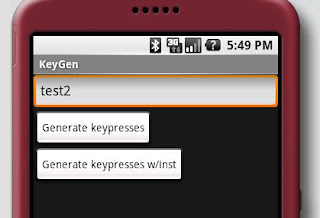The critical method in android.app.Instrumentation is this:
.method public sendKeySync(Landroid/view/KeyEvent;)V
.catch android/os/RemoteException from le5cf6 to le5d12 using le5d14
invoke-direct {v2},android/app/Instrumentation/validateNotAppThread
; validateNotAppThread()V
le5cf6:
const-string v0,"window"
invoke-static {v0},android/os/ServiceManager/getService
; getService(Ljava/lang/String;)Landroid/os/IBinder;
move-result-object v0
invoke-static {v0},android/view/IWindowManager$Stub/asInterface
; asInterface(Landroid/os/IBinder;)Landroid/view/IWindowManager;
move-result-object v0
const/4 v1,1
invoke-interface {v0,v3,v1},android/view/IWindowManager/injectKeyEvent
; injectKeyEvent(Landroid/view/KeyEvent;Z)Z
le5d12:
return-void
le5d14:
move-exception v0
goto le5d12
.end method
This is actually a public API method. The method obtains the binder of the WindowManagerService from the ServiceManager then it invokes the injectKeyEvent method on WindowManagerService's public interface. That is something we can do ourselves, can't we?
Click here to download the example program.
Unfortunately the situation is not that simple. Ever since the non-public classes like android.os.ServiceManager, android.view.IWindowManager, etc. were removed from android.jar, applications using non-public API cannot be compiled as easily as before. If you check the example program, you will see that I created stubs for these classes. These stubs are only there to allow compilation of the program, they don't get packaged into the apk file. On the platform itself, there will be real versions of them. In order to accomodate the stub compilation step, I modified somewhat the machine-generated build.xml file too.
It is also important to notice the validateNotAppThread private method invocation at the beginning of the method. Events cannot be generated neither from the application's own thread, nor from the UI thread. That's the reason we prepare another thread and install a looper into it. Then we post our actions into that thread and that thread will be able to generate keypresses.

If you launch the program and press the "Generate keypresses" button, you will see how the text field above the button receives the keypresses we generated programmatically. At this point you may get excited and would try to generate keypresses for other applications. This will not work. Android applications are allowed to generate keypresses only for themselves. In WindowManagerService class, you will find a permission check controlling this behaviour.
iget-object v1,v12,com/android/server/WindowManagerService.mContext Landroid/content/Context;
const-string v2,"android.permission.INJECT_EVENTS"
invoke-virtual {v1,v2,v14,v15},android/content/Context/checkPermission
; checkPermission(Ljava/lang/String;II)I
move-result v1
if-eqz v1,l4a7e0
const-string v1,"WindowManager"
new-instance v1,java/lang/StringBuilder
invoke-direct {v1},java/lang/StringBuilder/
;()V
const-string v2,"Permission denied: injecting key event from pid "
The android.permission.INJECT_EVENT permission is not that of the application, the WindowManagerService must have this permission otherwise requests to inject events into other applications' windows will be rejected. By default, WindowManagerService does not have this permission, that is why it is impossible to generate events for somebody else's window.
After all this diving into Android's internals, I show that there is a simpler way to generate key events by abusing the android.app.Instrumentation class. Check out the generateKeysWInst method in the example program. This method simply instantiates the Instrumentation class and calls only the sendKeyDownUpSync public method. This works because we know that sendKeyDownUpSync is so simple that it will function even with this bizarrely created instrumentation object. I don't know which method is more futureproof: using internal, non-public API or abusing a public API. Decide yourself.



 1:11 PM
1:11 PM
 sempax
sempax

 Posted in:
Posted in:
0 comments:
Post a Comment